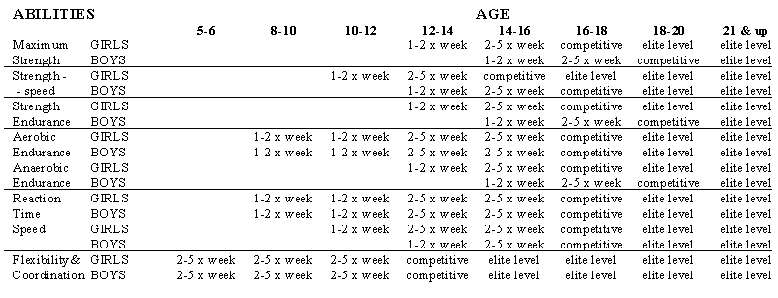
Basics / Sport-scientific Scripts
Dominant Abilities / Coordination / Strength / Speed / Endurance / Technique / What happens to the body when it gets in motion / Conditioning for Rowing / Anaerobic Threshold / Heart-rate Training -zones / Phases of Adaptation / Supercompensation / Annual Programming / Variety / Training for Young Athletes / Advice for young rowers 
Training for Young Athletes / 年輕選手的訓練
When analyzing the training of young athletes, it is very important to understand the sensitive periods for developing particular physical abilities. A child does not develop characteristics such as coordination, strength, speed, and endurance together. Some abilities can be developed early in life while some not until much later. For example, coordination and flexibility can be developed from as early as age three, whereas maximal endurance of an elite athlete may not peak until age thirty. Very young athletes who seem exceptionally talented because they master skills easily and quickly often do so because they have a naturally high level of coordination, speed, strength or a combination of the three. They are often best suited for games and other sports requiring a high degree of technical proficiency. On the other hand, young athletes who appear clumsy, uncoordinated or slow may have a naturally high level of endurance, which is not developed until the athlete matures. They are often best suited for sports, where technique is subordinate to other abilities such as running, swimming, cross-country skiing, etc.
 |
This table shows general ranges for the development of specific physical abilities. It does not consider the necessity for the development of technical and tactical abilities which, in my opinion, can and should be introduced even earlier. This is especially true in highly technical sports such as swimming, gymnastics, tennis, fencing and some games. The introduction of exercises and tasks related to development of characteristics needed for a sport should always precede participation in that sport. Kids don't start out performing complex gymnastics routines. They first work on becoming flexible and executing simplified versions of complex movements they will use later. In the same way, a future runner should not start out by simply running and a future hockey player should not start out playing hockey games.
All aspects of the relationship of sport training come down to finding an optimum and timely connection with ongoing dynamic changes occurring in the growing human body. Properly designed and executed sports training and physical education programs can have several positive outcomes. They not only create a well developed base for future intensive and specialized training, they also help to bring up universally developed, healthy, young people who, in the future, will be active participants and supporters of sports activities. Looking once again at the table of physical abilities, you can see that the process of full athletic development takes many years. Some characteristics such as maximal strength and anaerobic capacity cannot be developed until puberty or later. Introducing training based on these abilities too early is a mistake, but avoiding them completely may have equally bad consequences.
At some point, with proper multilateral development, every athlete will begin to show signs of proficiency in one or many sports. Often they will become excited about a particular sport or begin to excel with relative ease. At this point, the athlete should be encouraged to decide which sport they like and want to focus on. Specialization is the natural outcome of this development process. In some cases it may be too early for the athlete to start fully specialized training, but the emphasis toward the chosen sport will begin to emerge.
Copyright 1999 Sport is Life 21 January, 2000